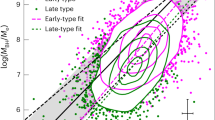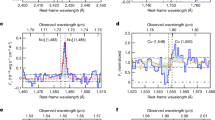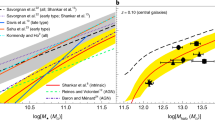Abstract
A long-standing question is whether active galactic nuclei (AGN) vary like Galactic black hole systems when appropriately scaled up by mass1,2,3. If so, we can then determine how AGN should behave on cosmological timescales by studying the brighter and much faster varying Galactic systems. As X-ray emission is produced very close to the black holes, it provides one of the best diagnostics of their behaviour. A characteristic timescale—which potentially could tell us about the mass of the black hole—is found in the X-ray variations from both AGN and Galactic black holes1,2,3,4,5,6, but whether it is physically meaningful to compare the two has been questioned7. Here we report that, after correcting for variations in the accretion rate, the timescales can be physically linked, revealing that the accretion process is exactly the same for small and large black holes. Strong support for this linkage comes, perhaps surprisingly, from the permitted optical emission lines in AGN whose widths (in both broad-line AGN and narrow-emission-line Seyfert 1 galaxies) correlate strongly with the characteristic X-ray timescale, exactly as expected from the AGN black hole masses and accretion rates. So AGN really are just scaled-up Galactic black holes.
This is a preview of subscription content, access via your institution
Access options
Subscribe to this journal
Receive 51 print issues and online access
$199.00 per year
only $3.90 per issue
Buy this article
- Purchase on Springer Link
- Instant access to full article PDF
Prices may be subject to local taxes which are calculated during checkout



Similar content being viewed by others
References
McHardy, I. M. EXOSAT observations of variability in active galactic nuclei. Mem. Soc. Astron. Ital. 59, 239–259 (1988)
Edelson, R. & Nandra, K. A cutoff in the X-ray fluctuation power density spectrum of the Seyfert 1 galaxy NGC 3516. Astrophys. J. 514, 682–690 (1999)
Uttley, P., McHardy, I. M. & Papadakis, I. E. Measuring the broad-band power spectra of active galactic nuclei with RXTE. Mon. Not. R. Astron. Soc. 332, 231–250 (2002)
Markowitz, A. et al. X-ray fluctuation power spectral densities of Seyfert 1 galaxies. Astrophys. J. 593, 96–114 (2003)
McHardy, I. M., Papadakis, I. E., Uttley, P., Page, M. J. & Mason, K. O. Combined long and short time-scale X-ray variability of NGC 4051 with RXTE and XMM-Newton. Mon. Not. R. Astron. Soc. 348, 783–801 (2004)
Papadakis, I. E. The scaling of the X-ray variability with black hole mass in active galactic nuclei. Mon. Not. R. Astron. Soc. 348, 207–213 (2004)
Done, C. & Gierlinski, M. Scaling variability from stellar to supermassive black holes. Mon. Not. R. Astron. Soc. 364, 208–216 (2005)
Lawrence, A., Watson, M. G., Pounds, K. A. & Elvis, M. Low-frequency divergent X-ray variability in the Seyfert galaxy NGC4051. Nature 325, 694–696 (1987)
McHardy, I. M & Czerny, B. Fractal X-ray time variability and spectral invariance of the Seyfert galaxy NGC5506. Nature 325, 696–698 (1987)
Axelsson, M., Borgonovo, L. & Larsson, S. Evolution of the 0.01-25 Hz power spectral components in Cygnus X-1. Astron. Astrophys. 438, 999–1012 (2005)
McHardy, I. M., Gunn, K. F., Uttley, P. & Goad, M. R. MCG-6-30-15: long time-scale X-ray variability, black hole mass and active galactic nuclei high states. Mon. Not. R. Astron. Soc. 359, 1469–1480 (2005)
Uttley, P. & McHardy, I. M. X-ray variability of NGC 3227 and 5506 and the nature of active galactic nucleus ‘states’. Mon. Not. R. Astron. Soc. 363, 586–596 (2005)
McClintock, J. E. & Remillard, R. A. in Compact Stellar X-ray Sources (eds Lewin, W. H. G. & van der Klis, M.) 157–213 (Cambridge Univ. Press, Cambridge, UK, 2006)
Lyubarskii, I. E. Flicker noise in accretion discs. Mon. Not. R. Astron. Soc. 292, 679–685 (1997)
Trudolyubov, S. P. On the two types of steady hard X-ray states of GRS 1915+105. Astrophys. J. 558, 276–282 (2001)
Wilms, J., Nowak, M. A., Pottschmidt, K., Pooley, G. & Fritz, S. Long term variability of Cygnus X-1. IV. Spectral evolution 1999-2004. Astron. Astrophys. 447, 245–261 (2006)
Pottschmidt, K. et al. Long term variability of Cygnus X-1. I. X-ray spectral-temporal correlations in the hard state. Astron. Astrophys. 407, 1039–1058 (2003)
Liu, B. F., Yuan, W., Meyer, F., Meyer-Hofmeister, E. & Xie, G. Z. Evaporation of accretion disks around black holes: The disk-corona transition and the connection to the advection-dominated accretion flow. Astrophys. J. 527, L17–L20 (1999)
Nowak, M. A. Are there three peaks in the power spectra of GX 339-4 and Cyg X-1?. Mon. Not. R. Astron. Soc. 318, 361–367 (2000)
Migliari, S., Fender, R. P. & van der Klis, M. Correlation between radio luminosity and X-ray timing frequencies in neutron star and black hole X-ray binaries. Mon. Not. R. Astron. Soc. 363, 112–120 (2005)
Merloni, A., Heinz, S. & di Matteo, T. A fundamental plane of black hole activity. Mon. Not. R. Astron. Soc. 345, 1057–1076 (2003)
Falcke, H., Koerding, E. & Markoff, S. A scheme to unify low-power accreting black holes. Jet-dominated accretion flows and the radio/X-ray correlation. Astron. Astrophys. 414, 895–903 (2004)
Turner, T. J., George, I. M., Nandra, K. & Turcan, D. On X-ray variability in Seyfert galaxies. Astrophys. J. 524, 667–673 (1999)
Leighly, K. M. A comprehensive spectral and variability study of narrow-line Seyfert 1 galaxies observed by ASCA. I. Observations and time series analysis. Astrophys. J. Suppl. 125297–316 (1999)
Bentz, M. C., Peterson, B. M., Pogge, R. W., Vestergaard, M. & Onken, C. A. The radius-luminosity relationship for active galactic nuclei: The effect of host-galaxy starlight on luminosity measurements. Astrophys. J. 644, 133–142 (2006)
Peterson, B. M. et al. Central masses and broad-line region sizes of active galactic nuclei. II. A homogeneous analysis of a large reverberation-mapping database. Astrophys. J. 613, 682–699 (2004)
Kollatschny, W., Zetzl, M. & Dietrich, M. Spectral line variability amplitudes in active galactic nuclei. Astron. Astrophys. 454, 459–472 (2006)
Brandt, W. N., Boller, Fabian, A. C. & Ruskowski, M. ROSAT High-Resolution Imager monitoring of extreme X-ray variability in the narrow-line quasar PHL 1092. Mon. Not. R. Astron. Soc. 303, L53–L57 (1999)
Peterson, B. M. et al. X-ray and optical variability in NGC 4051 and the nature of narrow-line Seyfert 1 galaxies. Astrophys. J. 542, 161–174 (2000)
Nagar, N. M., Oliva, E., Marconi, A. & Maiolino, R. NGC 5506 unmasked as a narrow line Seyfert 1:. A direct view of the broad line region using near-IR spectroscopy. Astron. Astrophys. 391, L21–L24 (2002)
Acknowledgements
This work was supported by the UK Particle Physics and Astronomy Research Council (PPARC). We thank P. Smith for discussions about statistics, P. Arevalo for determining the break timescale in GRS 1915+105 and D. Summons for providing some RXTE lightcurves of Cyg X-1.
Author information
Authors and Affiliations
Corresponding author
Ethics declarations
Competing interests
Reprints and permissions information is available at www.nature.com/reprints. The authors declare no competing financial interests.
Supplementary information
Supplementary information
This file contains the study of the scaling relationship between Active Galactic Nuclei (AGN) and Galactic Black Hole X-ray binary systems (GBHs) by means of comparing the way in which their X-ray emission varies. The study also shows how the widths of the permitted optical emission lines, a fundamental tracer of larger scale AGN properties often used to classify AGN, are intimately related to the way in which the timing properties from large to small black holes are scaled. (DOC 86 kb)
Rights and permissions
About this article
Cite this article
McHardy, I., Koerding, E., Knigge, C. et al. Active galactic nuclei as scaled-up Galactic black holes. Nature 444, 730–732 (2006). https://doi.org/10.1038/nature05389
Received:
Accepted:
Issue Date:
DOI: https://doi.org/10.1038/nature05389
This article is cited by
-
Novel Data Analysis Techniques in Coronal Seismology
Space Science Reviews (2022)
-
Study of accretion flows around an ultraluminous X-ray source M82 X-1 using NuSTAR data
Journal of Astrophysics and Astronomy (2022)
-
X-ray quasi-periodic eruptions from two previously quiescent galaxies
Nature (2021)
-
Highly polarized microstructure from the repeating FRB 20180916B
Nature Astronomy (2021)
-
Reverberation in Tidal Disruption Events: Dust Echoes, Coronal Emission Lines, Multi-wavelength Cross-correlations, and QPOs
Space Science Reviews (2021)
Comments
By submitting a comment you agree to abide by our Terms and Community Guidelines. If you find something abusive or that does not comply with our terms or guidelines please flag it as inappropriate.



